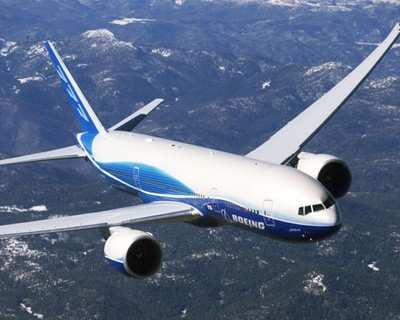Wed, Dec 14, 2011
Allows More Direct Flights, Burns Less Fuel, Emits Less Carbon
Dioxide Into Atmosphere
The FAA has approved ETOPS operation for Boeing's 777 fleet of
up to 330-minutes. The authorization allows 777 customers who
purchase or already operate 777-300ER (extended range), 777-200LR
(longer range), 777 Freighter and 777-200ER models equipped with
General Electric engines to fly up to 330 minutes from an alternate
airport. FAA approval for the 777-200ER equipped with Rolls-Royce
and Pratt & Whitney engines is expected to follow over the next
few months.

"Boeing twin-engine jets have flown more than 7 million ETOPS
flights since 1985, and more than 120 Boeing operators fly more
than 50,000 ETOPS flights each month," said Larry Loftis, vice
president and general manager 777 program. "This is the logical
continuation of the Boeing philosophy of point-to-point service.
Passengers want to minimize their overall travel time. This is one
more step in that direction."
The first airline to purchase the new longer ETOPS option is Air
New Zealand. Air New Zealand completed the first 240 ETOPS flight
earlier this month from Los Angeles to Auckland, N.Z.
"What this means is that the airplane is able to fly a
straighter route between the city pairs and that's good for the
environment," said Capt. David Morgan, chief pilot for Air New
Zealand. "Less fuel is burned and less carbon dioxide is emitted
into the atmosphere. It's also good for customers because flights
are potentially shorter and passengers could arrive sooner at their
destinations."
The new FAA approval allows airlines that operate routes in the
south Pacific, over the North Pole, and from Australia to South
America and southern Africa to fly the most direct routes.
An increasing number of operators already are providing ETOPS
service to their passengers. For example, 93 percent of 777, 50
percent of 767 and 33 percent of 757 operators fly ETOPS routes.
Two-engine ETOPS routes are more than 60 minutes from an alternate
airport.
The 777 fleet has flown more than 2 million ETOPS flights since
its debut in June 1995. Fifty-three 777 operators fly more than
22,000 ETOPS flights per month.
More News
Aero Linx: Model Aeronautical Association of Australia MAAA clubs are about fun flying, camaraderie and community. For over 75 years, the MAAA has been Australia’s largest fl>[...]
Touchdown Zone Lighting Two rows of transverse light bars located symmetrically about the runway centerline normally at 100 foot intervals. The basic system extends 3,000 feet alon>[...]
“Discovery and innovation are central to our mission at Virgin Galactic. We’re excited to build on our successful record of facilitating scientific experiments in subor>[...]
How To Get A Story On Aero-TV News/Feature Programming How do I submit a story idea or lead to Aero-TV? If you would like to submit a story idea or lead, please contact Jim Campbel>[...]
Student Pilot Reported That During Rotation, “All Of A Sudden The Back Of The Plane Kicked To The Right..." Analysis: The student pilot reported that during rotation, “>[...]
 ANN's Daily Aero-Linx (05.02.24)
ANN's Daily Aero-Linx (05.02.24) ANN's Daily Aero-Term (05.02.24): Touchdown Zone Lighting
ANN's Daily Aero-Term (05.02.24): Touchdown Zone Lighting Aero-News: Quote of the Day (05.02.24)
Aero-News: Quote of the Day (05.02.24) ANN FAQ: Contributing To Aero-TV
ANN FAQ: Contributing To Aero-TV NTSB Final Report: Cirrus Design Corp SR20
NTSB Final Report: Cirrus Design Corp SR20



